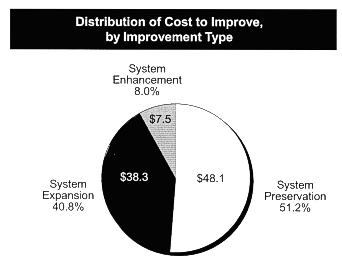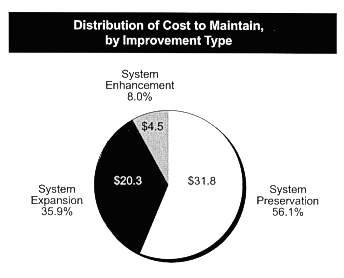U.S. Department of Transportation
Federal Highway Administration
1200 New Jersey Avenue, SE
Washington, DC 20590
202-366-4000
| |
| Conditions and Performance Report Executive Summary |
| Executive Summary Chapter Listing Conditions and Performance Home Page
|
|
The scope of the investment requirements outlined in this report has been expanded to cover all types of highway capital outlay. In previous editions of the report, improvements primarily related to system enhancement (including safety, traffic operations and environmental improvements) and economic development were excluded. The average annual Cost to Improve Highways and Bridges for the 20-year period 1998–2017 is $94.0 billion. This represents the investment by all levels of government required to imple-ment all cost beneficial improvements on highways ($83.4 billion Maximum Economic Investment scenario) plus the investment required to eliminate all bridge deficiencies ($10.6 billion Eliminate Deficiencies scenario). Investment requirements for system preservation comprise 51.2 percent of the total $94.0 billion Cost to Improve Highways and Bridges. Invest-ment requirements for system expansion account for 40.8 percent, while investment requirements for system enhancement make up 8.0 percent of the total.  |
The average annual investment over 20 years by all levels of government required for the Cost to Maintain Highways and Bridges is $56.6 billion. Included in this total are the highway Maintain Conditions scenario ($50.8 billion) which maintains pavement condition, and the bridge Maintain Backlog scenario ($5.8 billion), which maintains the backlog of current bridge deficiencies.  This highway Maintain Conditions scenario consists of a mix of preservation, expansion, and enhancement improvements intended to attain the highest possible level of benefits for highway users, while achieving its goal of maintaining pavement conditions. At this level of investment, pavement condition would be maintained, but highway system performance would decline. Average highway user costs (including travel time costs, vehicle operating costs, and crash costs) would rise. An additional $3.1 billion from all levels of government would be required annually to maintain highway user costs. Maintaining travel time costs would require an additional $17.1 billion annually. |